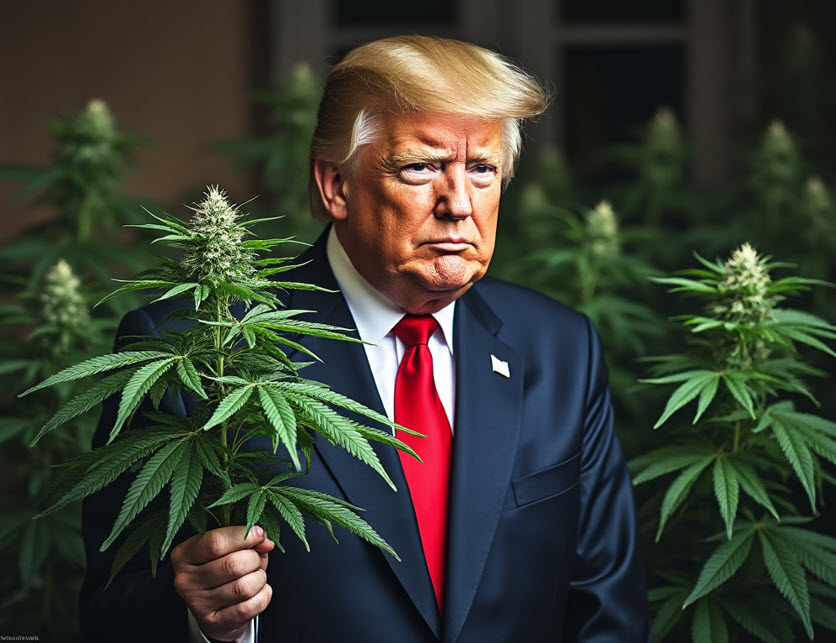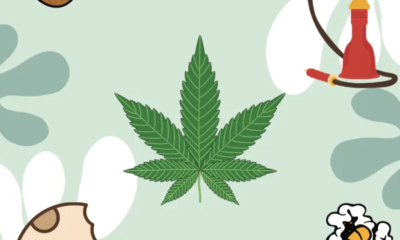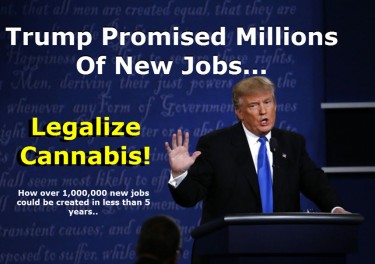Cannabis News
Trump 2.0 Cannabis Reform? – What to Expect When Republicans Control Washington
Published
4 weeks agoon
By
admin

In a turn of events that will reshape America’s cannabis policy landscape, Donald Trump has secured a second term as president, with Republicans gaining control of both chambers of Congress. This new political reality presents an unexpected opportunity for cannabis reform, albeit through a different lens than many advocates might have expected.
Trump’s evolution on cannabis policy has been remarkable. From his 1990s stance advocating for complete drug legalization to his recent endorsement of Florida’s cannabis initiative, his positions reflect a pragmatic adaptation to changing times. While his campaign rhetoric about drug dealers and cartels raised eyebrows, it’s crucial to understand that these comments targeted fentanyl traffickers, not the cannabis industry.
What makes this moment particularly intriguing is Trump’s recent cannabis policy declarations, coupled with his potential appointment of Robert F. Kennedy Jr. as health czar. This combination, along with unified Republican control of Congress, could create an unprecedented opportunity for federal cannabis reform – though perhaps not in the way many industry observers anticipated.
The landscape before us isn’t about aggressive federal legalization or social equity programs. Instead, we’re looking at the potential for a streamlined, business-friendly approach to cannabis reform that could actually succeed where previous attempts have failed. With Republicans controlling all levers of power, we might finally see a pragmatic path forward that prioritizes states’ rights, banking access, and basic federal frameworks over more controversial social programs.
As we unpack what cannabis reform might look like under Trump’s second term, it’s important to understand that the Republican Party of 2024 isn’t necessarily the anti-cannabis force it once was. In fact, with the right approach, this could be the breakthrough moment the industry has been waiting for.
Trump’s approach to cannabis policy has crystallized into something both pragmatic and distinctly Republican. His recent endorsement of Florida’s legalization initiative, though it ultimately fell short of the required 60% threshold, signals a significant shift in conservative cannabis politics. “Someone should not be a criminal in Florida, when this is legal in so many other States,” Trump declared, capturing the growing Republican sentiment that criminalization of cannabis may no longer serve conservative interests.
What’s particularly noteworthy about Trump’s current stance is his three-pronged approach to reform. First, he’s committed to continuing the Biden administration’s push to reschedule cannabis to Schedule III, but with a crucial difference – he’s indicated this would be part of a broader strategy to unlock medical research rather than an end goal. Second, he’s voiced strong support for banking reform, which could finally resolve the industry’s financial access problems. Third, and perhaps most importantly, he’s maintained his commitment to states’ rights, allowing local markets to develop organically without federal interference.
The potential appointment of Robert F. Kennedy Jr. as health czar could be a game-changer for cannabis policy. Kennedy has been a vocal critic of pharmaceutical industry influence and supports comprehensive drug policy reform. Having him oversee agencies like the FDA, NIH, and other health organizations could lead to significant changes in how these bodies approach cannabis research and regulation. His presence could help dismantle some of the institutional barriers that have historically limited cannabis research and development.
Trump’s administration has also indicated a willingness to work with Congress on “common sense laws” regarding cannabis. This suggests a shift away from executive action toward legislative solutions – a approach that could prove more durable than administrative rescheduling. While this might seem slower than executive action, it actually addresses the fundamental legal issues that have plagued cannabis reform efforts.
What’s particularly interesting about Trump’s current position is how it differs from his first term. While his previous administration included anti-cannabis figures like Jeff Sessions, Trump’s second term team appears to be stacked with more reform-friendly voices. This isn’t just about RFK Jr. – there are indications that other key appointments could favor a more progressive approach to cannabis policy, albeit through a conservative lens.
What many cannabis advocates fail to understand is that Republican opposition to cannabis reform has never been about the plant itself – it’s been about how legalization is implemented. The GOP’s resistance to previous reform efforts has largely centered on their rejection of social equity programs and heavy-handed federal oversight rather than opposition to legalization itself.
This Republican-controlled Congress presents a unique opportunity for what we might call “clean” cannabis reform – a barebones federal framework that addresses core business issues without the additional layers of social programming that have traditionally stalled legislation. Think of it as Cannabis Reform 2.0: streamlined, business-focused, and built on conservative principles of free market economics and states’ rights.
Such a framework could include several key elements that Republicans have historically supported. First, a straightforward licensing scheme that emphasizes merit-based approval rather than demographic quotas. Second, comprehensive banking reform that would allow cannabis businesses to access financial services without jumping through extraordinary hoops. Third, interstate commerce provisions that would allow states with legal markets to trade with each other, creating a more efficient national market.
What makes this approach particularly viable is its alignment with core Republican values. By focusing on reducing government interference, promoting business growth, and respecting state sovereignty, such legislation could attract broad GOP support. It’s worth noting that many Republican legislators who have opposed previous cannabis bills have specifically cited issues with equity provisions and federal overreach, not with legalization itself.
Moreover, the economic arguments for cannabis reform resonate strongly with Republican fiscal priorities. The potential tax revenue, job creation, and economic growth from a properly regulated cannabis industry align perfectly with conservative economic objectives. By framing cannabis reform as an economic opportunity rather than a social justice initiative, Republicans could actually move faster on legalization than their Democratic counterparts.
This reality creates an interesting paradox: under unified Republican control, we might actually see more substantive cannabis reform than under divided government, albeit in a different form than many advocates originally envisioned. The key is understanding that Republican support for cannabis reform exists – it just needs to be packaged in a way that aligns with conservative principles.
The path to cannabis reform under a Republican-controlled government might actually bypass the bureaucratic quagmire of DEA rescheduling altogether. While the DEA continues to delay hearings until 2025 and beyond, Congress could take direct action to create a new federal framework for cannabis regulation that renders the scheduling debate moot.
This isn’t just theoretical – there’s historical precedent for Congress creating separate regulatory frameworks for controlled substances. Take alcohol, for example. Rather than trying to reschedule or deschedule alcohol within the Controlled Substances Act, Congress established distinct regulations for its production, distribution, and sale. A similar approach could work for cannabis, creating a clean slate without the baggage of decades-old drug war policies.
Under Trump’s second term, with Republican control of Congress, we could see legislation that:
-
Removes cannabis from the Controlled Substances Act entirely
-
Creates a streamlined federal regulatory framework similar to alcohol
-
Establishes clear banking and financial service guidelines
-
Enables interstate commerce between legal states
-
Protects state-level markets from federal interference
-
Streamlines research permissions and protocols
The key players in making this happen extend beyond Trump himself. RFK Jr.’s potential oversight of health agencies could dramatically reshape how we approach cannabis research and medical applications. The appointment of business-friendly regulators could help create practical frameworks that promote industry growth while maintaining necessary safeguards.
States would continue to serve as laboratories of democracy, maintaining their own regulatory systems while operating within a permissive federal framework. This approach aligns perfectly with traditional Republican values of federalism and states’ rights.
The timing could actually be perfect. With 38 states having some form of legal cannabis market and more coming online each year, the pressure for federal reform has never been greater. The cannabis industry has also matured significantly, developing sophisticated business practices and safety protocols that could inform federal policy.
Republicans might also see this as an opportunity to put their stamp on cannabis policy before changing demographics potentially shift control back to Democrats in future elections. By acting now, they could shape the industry’s future in ways that align with conservative principles while claiming credit for ending federal prohibition.
The Sticky Bottom Line
As we look ahead to Trump’s second term, it’s clear that cannabis reform could take a dramatically different path than many expected. While some industry advocates might mourn the loss of social equity programs or comprehensive federal oversight, the reality is that a streamlined, Republican-led approach to legalization might actually achieve what years of progressive efforts couldn’t: ending federal cannabis prohibition.
The key to success will be embracing pragmatism over idealism. A “perfect” cannabis bill that includes everything on every advocate’s wishlist has repeatedly failed to gain traction. But a focused bill that addresses core business issues – banking, interstate commerce, and basic federal frameworks – while respecting state sovereignty could find broad Republican support.
Trump’s potential administration, particularly with RFK Jr. at the health policy helm, suggests a unique opportunity to reshape federal cannabis policy. By focusing on research, reducing pharmaceutical industry influence, and promoting business development, this approach could create a more sustainable and dynamic cannabis industry than heavy-handed federal regulation would allow.
For industry stakeholders, this means adapting strategies and expectations. Rather than pushing for comprehensive reform packages, success might come from supporting targeted legislation that addresses specific issues. The cannabis industry has matured enough to operate effectively within a basic federal framework, much like the alcohol industry does.
We’re potentially standing at the threshold of cannabis liberation, just not in the way many envisioned. Rather than top-down federal control, we might see a more organic, market-driven approach to industry development. While this might seem like a compromise to some advocates, it could ultimately prove more effective at achieving the core goal: ending federal cannabis prohibition and allowing the industry to flourish.
The next few years will be crucial. With Republicans controlling all branches of government and Trump showing unprecedented support for cannabis reform, we have a unique window of opportunity. Success will depend on the industry’s ability to work within this new political reality and support practical, achievable reforms rather than holding out for perfect but unattainable solutions.
The path to cannabis liberation might not look exactly as we imagined, but it’s becoming increasingly clear. Sometimes, the best way forward isn’t the most obvious one, and in this case, conservative pragmatism might accomplish what progressive idealism couldn’t: finally ending federal cannabis prohibition in America.
TRUMP PROMISED NEW JOBS, SO WHY NOT WEED, READ ON…
You may like
-


Veterans With PTSD Are Given A Little Hope
-


FDA Approves Landmark Clinical Trial for Veterans with PTSD and Smoking Cannabis
-


Oregon Cannabis: Get Your OLCC Renewal or New Application in Before December 5th
-


How Organic Hemp Rolling Papers Affect the Flavor and Smoking Experience
-


Emerald’s 2024 Holiday Gift Guide
-


What Your Method of Cannabis Consumption Says About you
Cannabis News
FDA Approves Landmark Clinical Trial for Veterans with PTSD and Smoking Cannabis
Published
16 hours agoon
December 3, 2024By
admin

For decades, veterans and civilians alike have turned to cannabis to manage their PTSD symptoms, often finding relief where traditional pharmaceuticals fell short. Walk into any VA hospital, and you’ll likely find patients being prescribed a cocktail of medications – SSRIs like sertraline and paroxetine, anti-anxiety drugs like alprazolam, sleep aids like zolpidem, and sometimes even antipsychotics. Yet many vets report these medications leave them feeling like zombies, trading one set of problems for another.
As someone who’s been following cannabis policy for years, I’ve watched countless researchers bang their heads against the wall trying to study this plant’s potential for PTSD treatment. The roadblocks have been numerous and, frankly, ridiculous. Despite overwhelming anecdotal evidence and desperate pleas from the veteran community, getting approval for clinical trials involving smokable cannabis has been about as easy as teaching a cat to swim – theoretically possible, but practically impossible.
That’s why the FDA’s recent approval of a landmark clinical trial has caught my attention. After three years of back-and-forth negotiations, the Multidisciplinary Association for Psychedelic Studies (MAPS) finally got the green light to conduct a Phase 2 study examining smoked cannabis for PTSD in veterans. This isn’t just another sterile laboratory experiment – it’s designed to reflect real-world usage patterns, something we’ve desperately needed in cannabis research.
In this article, we’ll dive deep into what this study means for veterans, the cannabis community, and the future of federal legalization. We’ll explore why this research is groundbreaking, how it might reshape our understanding of cannabis as medicine, and what it could mean for the millions of Americans living with PTSD.
Let’s dive into what makes this study so groundbreaking. MAPS isn’t just dipping their toes in the water – they’re diving in headfirst with a comprehensive Phase 2 clinical trial involving 320 veterans suffering from moderate to severe PTSD. What makes this study particularly fascinating is its focus on “real-world” cannabis use, allowing participants to self-titrate their dosage of high-THC flower within certain limits.
Now, for those who aren’t familiar with the FDA’s clinical trial phases, let me break it down. Phase 1 typically focuses on safety and involves a small group of people. Phase 2 – where this study sits – is where things get interesting. It’s designed to test both effectiveness and side effects, involving a larger group of participants. If successful, Phase 3 would follow with an even larger group, and finally, Phase 4 would monitor long-term safety after FDA approval.
The fact that this study reached Phase 2 is a big deal, folks. It means we’ve cleared the initial safety hurdles and are moving into territory that could actually influence medical policy. But what really sets this research apart is its focus on smokable flower. This wasn’t an easy win – MAPS had to fight through five partial clinical hold letters from the FDA just to get here.
Why does the smoking aspect matter so much? Well, think about it – most FDA-approved medications come in neat little pills or carefully measured doses. Smoking cannabis? That’s been a major sticking point for regulatory agencies. By including smoking as a delivery method, this study acknowledges how most veterans actually use cannabis in the real world. No fancy pharmaceutical extracts or synthetic compounds – just the plant in its most basic, smokable form.
The implications here are huge. If this study demonstrates positive results, it could fundamentally change how we approach cannabis as medicine. It might force regulatory bodies to reconsider their stance on smokable cannabis, potentially opening doors for more research and eventual federal approval of whole-plant medicine. This could be particularly significant for veterans, who often prefer smoking or vaping cannabis for its rapid onset and ease of dose control.
But perhaps most importantly, this study could provide the hard scientific evidence we’ve been missing. While thousands of veterans have testified about cannabis helping their PTSD, the lack of controlled clinical trials has been a major roadblock in changing federal policy. A successful outcome here could be the wedge we need to finally crack open the door to federal legalization.
Of course, we shouldn’t count our chickens before they hatch. Clinical trials are complex beasts, and there’s still a long road ahead. But for the first time in a long while, I’m feeling optimistic about the direction we’re heading. This study could be the game-changer we’ve been waiting for in the fight for cannabis legitimacy.
Let’s talk about PTSD – a condition that affects roughly 12 million American adults annually. That’s more people than the entire population of New York City, folks. Post-Traumatic Stress Disorder isn’t just about being scared or anxious; it’s a complex psychological condition where traumatic experiences get stuck in an endless replay loop, like a scratched record that keeps skipping back to the same devastating track.
But here’s where cannabis enters the picture, and it’s fascinating how it works. Our endocannabinoid system plays a crucial role in how we process and store memories, particularly emotional ones. When someone consumes cannabis, it can help disrupt those stubborn neural pathways that keep trauma loops running. Think of it like hitting the pause button on a horror movie that’s been playing on repeat in someone’s head.
However – and this is crucial – cannabis isn’t a magic eraser for trauma. I’ve spoken with countless veterans who use cannabis, and they’re the first to tell you: the plant helps manage symptoms, but it doesn’t “cure” PTSD. Real healing requires doing the hard work of processing and integrating traumatic experiences. Cannabis is more like a helpful companion on that journey rather than the destination itself.
What makes cannabis particularly interesting in PTSD treatment is its ability to increase neuroplasticity – the brain’s ability to form new neural connections and reorganize existing ones. This is where the real magic happens. When someone’s brain becomes more “plastic,” they’re better equipped to process traumatic memories and potentially create new, healthier neural pathways.
Speaking of neuroplasticity, we can’t ignore the elephant in the room – psilocybin. Recent studies have shown remarkable promise in treating PTSD with psilocybin-assisted therapy, often producing profound and lasting changes in just a few sessions. The fact that both cannabis and psilocybin increase neuroplasticity while offering different therapeutic approaches suggests we might be onto something big in trauma treatment.
What drives me crazy is how long it’s taken to get here. We’ve known about cannabis’s potential benefits for PTSD for decades. Veterans have been telling us. Trauma survivors have been telling us. Heck, even some forward-thinking psychiatrists have been telling us. Yet we’re only now getting around to serious clinical research? It’s a testament to how prohibition hasn’t just restricted access to cannabis – it’s actively delayed our understanding of this plant’s therapeutic potential.
But hey, better late than never, right? As we move forward with studies like the MAPS trial, we’re finally starting to piece together the scientific puzzle that veterans and other PTSD survivors have known about all along. Cannabis isn’t just helping them sleep better or feel calmer – it’s potentially giving them the neurological flexibility they need to process and integrate their trauma in a healthy way.
Like most things in the cannabis reform movement, progress moves at a snail’s pace. But as frustrating as it might be, we’re undeniably moving forward. The FDA’s approval of this MAPS study, focusing on smokable cannabis no less, marks a significant shift in how our regulatory bodies view cannabis research.
The beauty of this study lies in its real-world approach. No artificial laboratory settings or synthetic cannabinoids – just veterans using cannabis the way they already do. This authenticity could provide invaluable data about how cannabis actually functions as a medicine in everyday life, not just in theory.
Let’s be real though – regardless of what this study finds, veterans and others suffering from PTSD who’ve found relief with cannabis aren’t going to stop using it. The plant has been their lifeline when traditional pharmaceuticals failed them. But positive findings could open doors for countless others who might benefit from cannabis but have been hesitant due to its federal status or lack of clinical validation.
This is particularly crucial for our veteran community. With veteran suicide rates remaining tragically high – averaging around 17 deaths per day – we desperately need more treatment options. It’s no coincidence that veteran groups have been among the loudest voices calling for cannabis research and reform. They’ve seen firsthand how this plant can offer hope where traditional treatments have fallen short.
As we await the results of this groundbreaking study, I remain cautiously optimistic. Sure, progress is slower than we’d like, but each step forward brings us closer to a future where veterans and others with PTSD can access the medicine they need without stigma or legal barriers. And for the countless individuals struggling with PTSD, that future can’t come soon enough.
Source:
www.marijuanamoment.net/fda-approves-long-awaited-clinical-trial-of-smoked-marijuana-to-treat-ptsd-in-veterans/
ARE PSYCHEDELICS JUST WEED 2.0? READ ON…
ARE MAGIC MUSHROOMS THE NEW WEED 2.0? WE ASKED THE EXPERTS!
Cannabis News
Oregon Cannabis: Get Your OLCC Renewal or New Application in Before December 5th
Published
17 hours agoon
December 3, 2024By
admin
As of this Thursday, December 5th, Ballot Measure 119 requires all OLCC licensed retailers, processors and labs to provide a signed labor peace agreement (LPA) with a bona fide labor organization, to renew or apply for an OLCC license.
In the totally avoidable, unduly compressed timeline since BM 119 passed, we have been advising our Oregon cannabis clients to renew their license applications ahead of the December 5th deadline if possible. Same deal for new applicants– get everything in before the deadline. This will allow qualifying businesses to avoid the LPA issue for another year (or maybe forever, if the courts get ahold of BM 119).
OLCC marijuana licensees are required to renew their licenses annually. Licensees are notified 90 days prior to their license expiration date that it’s time for license renewal. According to my wizard paralegal, this notice automatically posts in CAMP, which is the OLCC’s online licensing software. Specifically, a licensee will receive an “Actions Required” notification on their dashboard.
OLCC has confirmed that licenses set to expire after December 5th, will not require an LPA submission until the following year’s renewal, provided that the license has been renewed prior to the December 5th deadline. Same deal with any new license applicant. To that point, OLCC’s most recent BM 119 Bulletin is here. It answers some basic questions and contains no surprises.
OLCC also recently published its Labor Peace Agreement Attestation Form. This is a form that applicants may submit in lieu of actually filing their LPA with the Commission. Somebody asked me what the repercussions might be if they were to submit this form without having a signed LPA in place. The short answer is “don’t do that.” The longer answer is that there are many administrative rules dealing with “false statements”, “material false statements” and the submission of “false or misleading information” to OLCC. License revocation or non-renewal is a real possibility there.
For more information on this topic, the Cannabis Industry Alliance of Oregon has a guide here, and has been sending out helpful emails on its listserv (you can sign up for those here). The relevant OLCC materials are linked above, and I’ll provide links to our previous posts on this topic just below. For now, get those license renewals and applications in!
See also:
Cannabis News
Attention, Canna Companies! CTA Filing Deadline this Month
Published
2 days agoon
December 2, 2024By
admin
For anyone that has not yet met their Corporate Transparency Act (CTA) filing requirements, now is the time! The deadline for entities created or registered before January 1, 2024, is less than a month away, on December 31, 2024.
In July, we published a blog post covering questions on the CTA. The full text of that post is included below.
____________________________
On January 1, 2024, the federal Corporate Transparency Act (CTA) took effect. The CTA requires a host of both domestic and foreign entities to disclose their beneficial ownership to the Treasury’s Financial Crimes Enforcement Network (FinCEN). Compliance with the CTA is required for all businesses, including those in the cannabis industry. In this post, I’ll overview some (but not all) key requirements of the CTA, and some of the implications for the cannabis industry.
What is the CTA?
The purpose of the CTA is to combat illegal activities like money laundering by disclosure of information concerning “beneficial owners” to FinCEN. Beneficial ownership essentially means the individuals who own or control a company (more on that below). FinCEN and other domestic governmental authorities can use this beneficial ownership information in certain contexts for law enforcement purposes. Detailed FAQs on the CTA are available here.
Who must report?
Corporations, limited liability companies, and other business entities are considered reporting companies for purposes of the CTA. Certain sole proprietors may not count as reporting companies, and CTA exempts 23 classes of entities, such as governmental bodies, banks, and certain large operating companies.
Figuring out whether a business qualifies for an exemption can in some cases be complicated, and businesses can flow in and out of exemptions over time. So it’s a good idea for businesses to confer with counsel to determine whether they are compliant.
When must reporting happen?
Reporting is done by submitting an initial beneficial ownership report (BOIR) with FinCEN via an electronic portal called the Beneficial Ownership Secure System, located at FinCEN.gov, free of charge. There are some key reporting deadlines, which change based on when a company was formed (for domestic companies) or registered in the US (for foreign companies) as follows:
- Entities created or registered before January 1, 2024, must submit their initial BOIR by January 1, 2025.
- Entities registered in 2024 are required to file within 90 calendar days of their registration becoming effective.
- For registrations from January 1, 2025, onwards, the deadline is 30 calendar days post-registration notice.
CTA also has requirements to periodically update beneficial ownership information after changes occur. Failure to comply with CTA can lead to monetary penalties and even criminal liability.
What must be reported?
Reporting companies must disclose individuals with substantial control or those owning at least 25% of the entity. Substantial control includes abilities like appointing or removing directors, making significant business decisions, or other forms of major influence. For example, question D8 on FinCEN’s FAQs addresses how management companies could be considered beneficial owners of a reporting company. Sound familiar?
Disclosure itself is not dissimilar to state-level cannabis regulatory disclosures. Beneficial owners must provide their legal name, date of birth, address, and an identifying number (e.g., SSN).
How will this affect the cannabis industry?
In case you were wondering, CTA applies to cannabis businesses. There is no exemption for reporting by state-legal cannabis companies.
A lot of cannabis companies will probably get squeamish at the thought of making detailed beneficial ownership disclosures. That’s especially the case where CTA by its terms allows FinCEN to share beneficial ownership information with other federal agencies engaged in law enforcement activities, or federal agencies that supervise financial institutions.
So, expect to see owners of cannabis businesses engage in all kinds of corporate changes to obscure beneficial ownership or reduce equity and control rights to get out of disclosures. In some cases, this will not work and people will face penalties.
Also expect to see a lot of cannabis companies (and non-cannabis companies for that matter) make a good-faith effort to comply with CTA initially but fail to update information as required by law. This is just going to happen, the way CTA is set up. Whether or not people are actually penalized for late disclosures or updates absent some kind of misfeasance remains to be seen.
Conclusion
CTA is complicated and has already been a headache for many businesses – so much so that at least one group of businesses brought a challenge to its constitutionality and won. Fortunately or unfortunately (depending on how you look at it) the court did not issue a nationwide injunction but only enjoined enforcement of CTA against the specific plaintiffs. It’s possible that in different litigation or future appeals, the law itself is enjoined on a nationwide level. But for the time being, it’s the law of the land.

Veterans With PTSD Are Given A Little Hope

FDA Approves Landmark Clinical Trial for Veterans with PTSD and Smoking Cannabis

Oregon Cannabis: Get Your OLCC Renewal or New Application in Before December 5th

How Organic Hemp Rolling Papers Affect the Flavor and Smoking Experience

Emerald’s 2024 Holiday Gift Guide

What Your Method of Cannabis Consumption Says About you

DEA Hearings – Yesterday’s (12/2/2024) Livestream – 1:36

Keep it Lowkey with Discreet Cannabis Products

Can CBD Keep Cats From The Christmas Tree
Pennsylvania Lawmakers Announce New Marijuana Bill To Catch Up With Neighboring States That Have Already Legalized

Distressed Cannabis Business Takeaways – Canna Law Blog™

United States: Alex Malyshev And Melinda Fellner Discuss The Intersection Of Tax And Cannabis In New Video Series – Part VI: Licensing (Video)

What you Need to Know

Drug Testing for Marijuana – The Joint Blog

NCIA Write About Their Equity Scholarship Program

It has been a wild news week – here’s how CBD and weed can help you relax

Cannabis, alcohol firm SNDL loses CA$372.4 million in 2022

A new April 20 cannabis contest includes a $40,000 purse

Your Go-To Source for Cannabis Logos and Designs

UArizona launches online cannabis compliance online course
Trending
-

 Cannabis News2 years ago
Cannabis News2 years agoDistressed Cannabis Business Takeaways – Canna Law Blog™
-

 One-Hit Wonders2 years ago
One-Hit Wonders2 years agoUnited States: Alex Malyshev And Melinda Fellner Discuss The Intersection Of Tax And Cannabis In New Video Series – Part VI: Licensing (Video)
-

 Cannabis 1012 years ago
Cannabis 1012 years agoWhat you Need to Know
-

 drug testing12 months ago
drug testing12 months agoDrug Testing for Marijuana – The Joint Blog
-

 Education2 years ago
Education2 years agoNCIA Write About Their Equity Scholarship Program
-

 Cannabis2 years ago
Cannabis2 years agoIt has been a wild news week – here’s how CBD and weed can help you relax
-

 Marijuana Business Daily2 years ago
Marijuana Business Daily2 years agoCannabis, alcohol firm SNDL loses CA$372.4 million in 2022
-

 California2 years ago
California2 years agoA new April 20 cannabis contest includes a $40,000 purse





